![]() If you’re enjoying this content, considering joining my Patreon to support future work.
If you’re enjoying this content, considering joining my Patreon to support future work.
Scrambling! Joyously moving on easy rock routes. In Boulder, we have a King’s ransom of big rocks to fumble about on and there’s a lifetime of routes to tick. The Flatirons are one of Boulder’s most iconic natural wonders. It’s somewhat impossible to roll into to town and not take a moment to look out west and imagine wandering in/out/around the various crags. Such a playground we have.
Below is a video I put together describing some of the shoes in my collection I use when running and scrambling:
Read on for even more trail running/approach shoe/scrambling talk:
First, Let’s Talk Approach Shoes
The magic to scrambling easy stuff with joy and delight is getting a good pair of approach shoes. These types of shoes differ from trail runners in quite a few ways. With runners, I size things generous to allow for foot swelling on long days and so that they function like a running shoe. Running shoes in general should not be fitted tightly, nor should you lace them so.
With an approach shoe, I do size tighter – between a street shoe and a climbing shoe. This gives me a little more sensitivity on the rock, my smedges (scrambling lingo: smearing an edge) feel more solid – and all around, the shoe functions like a climbing shoe that I can still walk in.
The rubber on the outsole is usually formulated to be stickier as well, at the tradeoff of not lasting as long. Performance in wet/icy conditions is also not as good, and the profile of any lugs is going to be much less chunkier. For scrambling, you want as much surface area as possible on the rock to aid in friction. In Sportiva’s line, they usually go with Vibram MegaGrip.
The midsole of an approach shoe is most likely going to be thinner to aid in sensitivity to the rock – you’re going to be able to feel small pebbles and nubbins under foot.
All these differences – and especially the way I prefer to size things makes approach shoes a different beast altogether from a trail runner. My two go-to approach shoes are the Sportiva TX2 and TX3. The TX2 is the more minimal of the pair and is the one I size down the most.
For example, I wear a size 46 Sportiva trail running shoe and I’ll size down to a 44 for my TX2’s. The TX3 is a little burlier than the ‘2, with more of a heel drop, more mid sole, and a tougher upper. I’ll size these as a 45, so I can hike/run in them all day. They’re still tight enough for me to feel confident on tougher scrambling, but also hike and run a little better than the ‘2. If all you wanna do is hike (rather than run) and are looking for that ankle support (which I rarely am), the line goes up to a TX4 and even the TXS – the higher the number generally means a more built up boot.
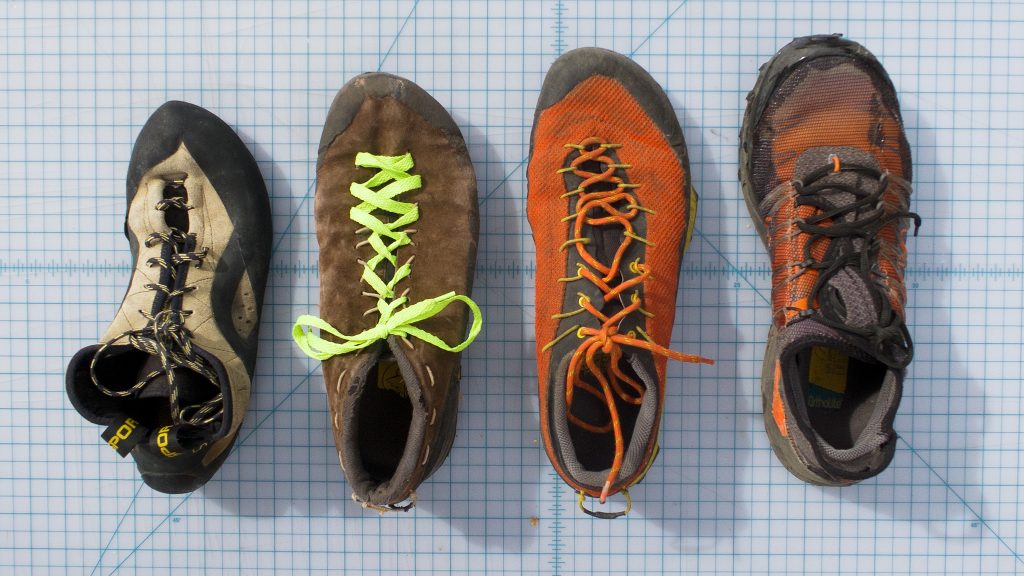
But I also employ this option on very long trips. For example on my Milner to Berthoud Pass trip that took over three days, I was actually wearing Sportiva Jackals – their all-day, super-cush model to help save my feet for the 70+ miles of the route, but I also brought along my TX2’s to take on the beacoup-amount of 5.easy pitches I needed to safely do alone. Both shoes had their strengths and weaknesses, and I was OK with taking the weight hit and taking a few minutes each day to switch out for each different secteur wasn’t a big deal.
On to the Options!
Coming to scrambling as more of a trail runner than a climber, the style of attack is usually to go fast – and to go fast, you go without. But the gear I do bring is carefully picked out to make my day as fun as possible. So what do I use?
Option #1: Trail Runners + Approach Shoes
More often than not, I’m starting my run wearing my favorite pair of trail runners (Sportiva Ultra Raptor or Mutant), and carrying a separate pair of approach shoes (Sportiva TX2’s) with me carried in my vest. I can run better in trail runners and scramble better in approach shoes, and switching them out saves wear and tear on both.
The downside is that switching between pairs takes time, so it’s not a technique usually used on short FKTs – I couldn’t PR my First Flatiron time from the TH doing this. But, I also usually enjoy a minute or two reprieve between methods of forward motion to regroup mentally, take in some water and eat on most of my runs.
A usual outing for me: from the TH, I’ll run to the the formation I want to start on. I usually prefer to use an off-trail route which is quiet (most of the flatirons are well off the main trails, anyways!) Once at the base of the scramble, I change into my approach shoes and start up the route. At the end of the route, I’ll switch back into my trail runners. Rinse and repeat.
But I also employ this option on very long trips. For example on my Milner to Berthoud Pass trip that took over three days, I was actually wearing Sportiva Jackals – their all-day, super-cush model to help save my feet for the 70+ miles of the route, but I also brought along my TX2’s to take on the beacoup-amount of 5.easy pitches I needed to safely do alone. Both shoes had their strengths and weaknesses, and I was OK with taking the weight hit and taking a few minutes each day to switch out for each different secteur wasn’t a big deal.
Option #2 Trail Runners Only
On some outings, I’ll just do my entire run/scrambling in my trail runners – often ones that have fairly sticky rubber saving me from having to haul two pairs of shoes. In Sportiva’s trail running lineup, look for shoes with the FriXion XF rubber, usually marked in white (and also known as FriXion White) in this year’s models. Shoes that have this rubber include Ultra Raptor, Kaptiva, and Mutant.
If I’m on the home trails shod in just my trail runners, I’m usually scrambling at a grade lower than I am with full-on approach shoes. But as one gets better at scrambling and becomes more confident, it’s pretty amazing what you can get up with a good pair of trail runners.
(Warning: If you’re just starting out, get a pair of approach shoes, or even comfy rock shoes and build up your own confidence slowly).
My own confidence is pretty high as I do a lot of climbing, but I still try to keep things well within the Chill Level while scrambling alone.
If I’m far away from home on an alpine adventure, I’m usually only bringing trail runners, since bringing another pair of shoes on a few miles of an approach (along with everything else) – and sometimes after a 40 mile bike ride(!) starts to weigh me down.
One option is to just go with trail runners and temper my expectations on what I’m scrambling. For example, most of my trips to Longs Peak are with just trail runners. The terrain constantly changes from trail, to talus, snow, and also some technical pitches – I’m already bringing a lot of other gear and food with me, and if I’m to even to be successful with what I want to do, I have to think hard on what is most important to my trip.
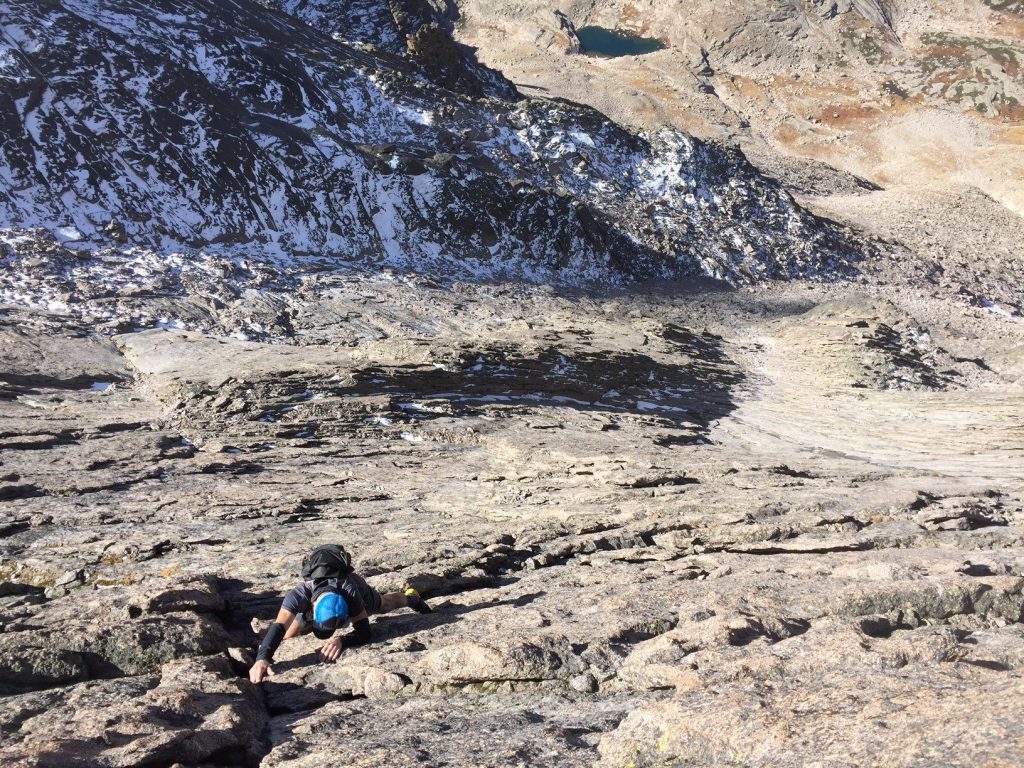
My Sangre de Cristo Range Ridge Traverse was also done with just trail runners. The trip was long, and I was already weighed down with 6+ days of food. Every once counted against me finishing the 120 line. So even though there was some semi-technical scrambling to do – most notably (but certainly not only) the Little Bear/Blanca traverse, I decided it best to not have different pairs of shoes to switch out.
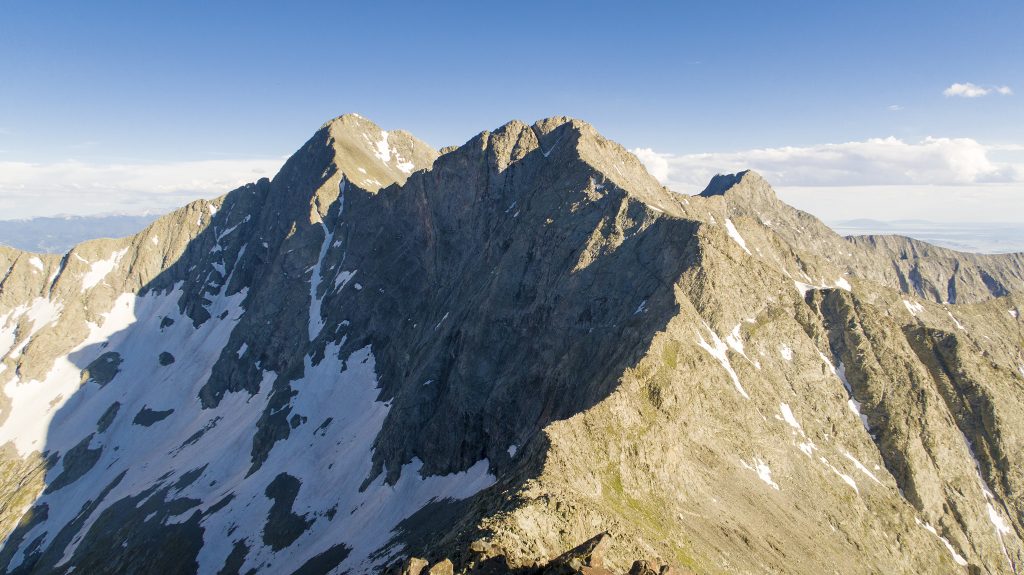
Option #3 Approach Shoes Only
Bet you guessed this one – you can always go out starting with approach shoes. I have two pairs of approach shoes I kick about in: a pair of TX2’s that are sized fairly tightly, and a pair of TX3’s that are fit smaller than my TX2’s, but not as generous as my trail runners. If the outing is short, I’ll just go with my TX2’s, but they’re too tight for me to actually run, so the mileage is low (<5 miles). If the outing is long, I’ll wear my TX3’s. The run-ability is still not great, but I’ve done a 30 mile day in them and lived to tell about it, and you’ll mostly be fine, too. The lack of cush and room in the upper does start to get old on the trail, though.
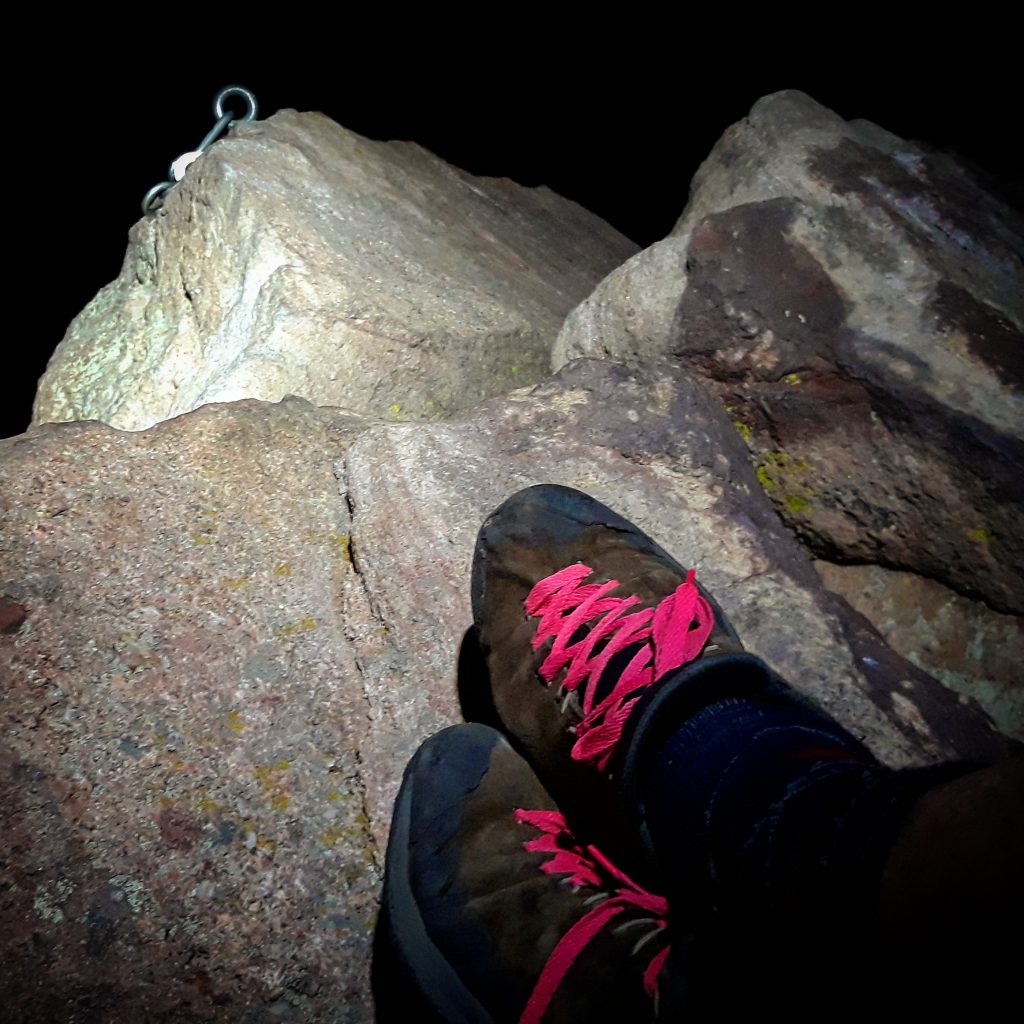
“Approach shoes only” is the option I go with if I want to set a PR on a route and switching out is just not in the cards when moving as fast as possible. It’s also the option I go with if I’m running in the alpine and I know the route I’ll hit is one I want a little extra confidence in, which my trail runners won’t give me and/or I’m with a group of people that aren’t interested in stopping all that much while I keep switching out my shoes!
For example, going to Brainard Lake and doing the entire Continental Divide ridgeline from Mt. Audubon to Navajo Peak is probably only going to be done in approach shoes.
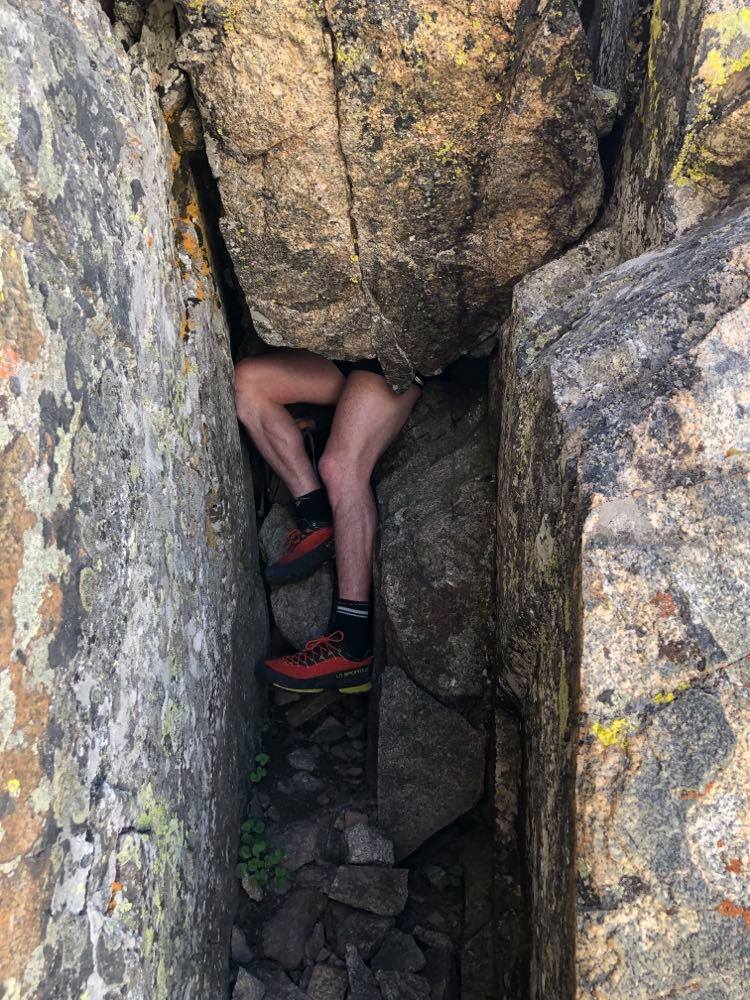
Bonus! Option: Rock Shoes
On rare occasions, I’ll take one of the above options but also bring along a pair of full on rock shoes – usually a pair of TC Pros. There’s a few formations in the Flatirons that I’m comfortable soloing, but not without an actual pair of climbing shoes. Purgatory on Satan’s Slab comes to mind. If I’m thinking of doing a route that needs rock shoes in the alpine, I’m alone, and I’m still thinking I’m doing a “run”, I may re-evaluate my plans – as this is not in the Chill Zone for me.
TC Pros are high-performance climbing shoes. If the price tag is too much for some insouciant scrambling, a pair of Tarantulace‘s will fit the bill nicely, without breaking the bank.
Bonus! Option #2: Resoled Trail Runners
Yet another option you experiment with is taking your favorite trail runner model and resoling it with sticky approach shoe rubber. Have the best of both worlds (almost)! A shoe you love to run in, shod with that sticky-icky for when things get steep. It’s a fun option, but the cost of a new trail runner (and it’s best to start with a new pair), and the cost of resoling (~$60/pair) adds up. What you get in return is a running shoe that doesn’t perform as well with the sticky rubber, and an approach shoe that doesn’t perform well as one custom-designed for the task. But that may not be important to you, if the benefits of only having one pair win out. This was a more attractive option when the options for runnable approach shoes were slim. If you want a runnable approach shoe, consider the TX Guide.
When going to your climbing resoler (here’s Rock and Resole’s approach shoe page), your two choices are usually between 5 Ten’s Dot Rubber or Vibram’s Dot, or Vibram Megagrip – all are very similar in performance. Rock and Resole also has, Angler rubber as an option – this is a rubber formulated to be slick in wet conditions, so may not be best for dry scrambling.
You could potentially talk your resoler in putting honest to goodness climbing rubber on the soles of your shoes, but it would be expensive and your resoler may talk you out of it, as the wear of walking in such a shoe for miles won’t be all that performative.
I’ve not done this resole option to any of my trail runners, but for all the models I personally own, the Ultra Raptor looks to be a good candidate. The TX2 and TX3 are both good candidates to get resoled and that’s something I have done. If you can keep the upper in good condition, both can take around 2 resoles before giving it and completely falling apart.
Just Starting Out?
If you’re just starting out to explore the Flatirons (for example), go with one shoe – I would suggest the TX3, and fit it like a regular runner or hiker. The shoe will serve you well in a variety of different jobs.
So that it’s – that’s my survey of scrambling shoes. Questions? Leave something in the comments.
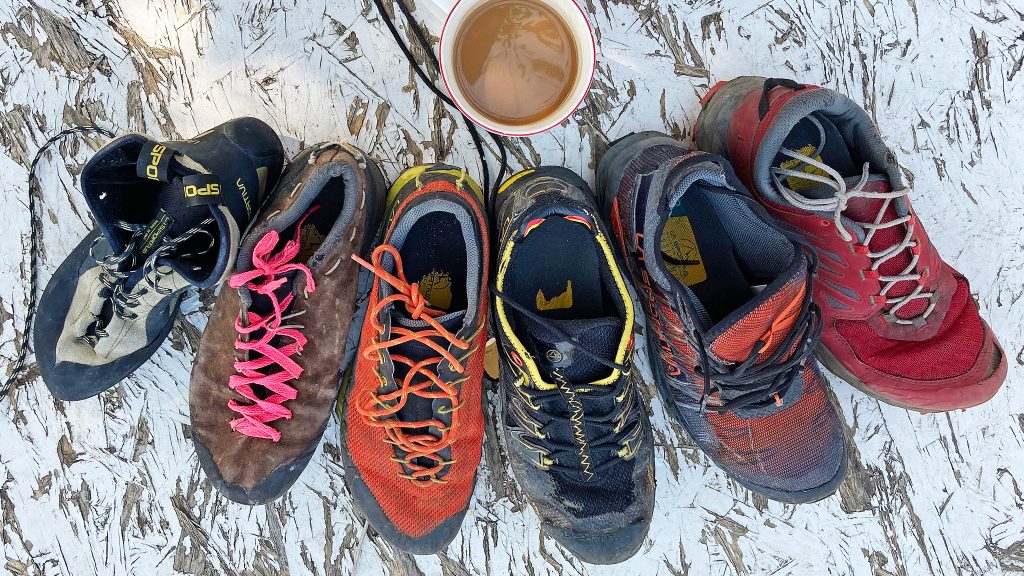

This is really good, a sign of the mixed running/climbing times… My scrambling outings are putzy compared to yours (<= 5.1), but we may all go through the same shoe calculus. Whatever the shoe, I go for something with either a Vibram sole or a compound from an alpine gear company that makes climbing shoes. Love the TX2, Mutant. I'm looking to up the game a little, may have to bring some rock shoes too.
Good rundown of the various options. I personally don’t bother with approach shoes since (IMHO) they are mediocre for hiking and running, bad for off-trail travel, and don’t offer much more confidence for scrambling than carefully-chosen trail runners. When I’m scrambling something close to my limit, I carry rock shoes, which actually do give me a grade or so more confidence.
Nota bene: I have been scrambling in trail runners for years, and have a good sense of both how to get the most out of them, and what to look for in a good model. Sportiva, Salomon, New Balance, and Adidas all make some good scrambling shoes, but also lots of bad ones.
Have you’ve ever been tempted to resole a pair of trail runners?
Any standout pairs of trailrunners as approach shoes you’d like to mention? I wanna say Adidas has some interesting stuff with their 5.10 crossover of rubber tech.
Hey Justin – I’m curious about your thoughts on Lock Laces. I was recommended it as a way to get my trail runners on faster. I have a slightly different lifestyle than you: but I need exercise every 2 hours so I’m constantly putting my shoes on/off for cycling / jogging / rock climbing and probably average 5x/day and have found the lock laces allow me to save a lot of time and also there’s no laces to get stuck in my front derailleur when I use trail runners with flats.
I’m trying to think of a reason I shouldn’t put these laces on all my TR’s & approach shoes?
Sorry – this comment slipped my radar. I’ve never used lock laces before, but they def. do have their fans. If you enjoy them, by all means. For “laces getting in the way of drivetrains” – there is a lace pattern that moves the ends to the right side of your shoes to kinda help that:
https://www.fieggen.com/shoelace/hikingbikinglacing.htm
I’ll tell ya what: if they made trail runners with velcro I’d be all over that. But I’ll take some hyper-tech BOA enclosure as well 😉